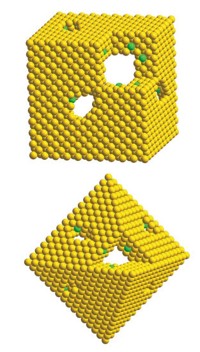Advertisement
Grab your lab coat. Let's get started
Welcome!
Welcome!
Create an account below to get 6 C&EN articles per month, receive newsletters and more - all free.
It seems this is your first time logging in online. Please enter the following information to continue.
As an ACS member you automatically get access to this site. All we need is few more details to create your reading experience.
Not you? Sign in with a different account.
Not you? Sign in with a different account.
ERROR 1
ERROR 1
ERROR 2
ERROR 2
ERROR 2
ERROR 2
ERROR 2
Password and Confirm password must match.
If you have an ACS member number, please enter it here so we can link this account to your membership. (optional)
ERROR 2
ACS values your privacy. By submitting your information, you are gaining access to C&EN and subscribing to our weekly newsletter. We use the information you provide to make your reading experience better, and we will never sell your data to third party members.
Synthesis
Confinement In Nanotubes Boosts Catalyst Performance
Chiral Catalysis: Nanoscale proximity of reactants enhances asymmetric hydrogenation
by Mitch Jacoby
March 9, 2011
| A version of this story appeared in
Volume 89, Issue 11
Platinum nanoparticles adsorbed inside carbon nanotubes are far more effective catalysts for asymmetric hydrogenation than particles adsorbed on nanotube exteriors or conventional support materials, according to researchers in China (Angew. Chem. Int. Ed., DOI: 10.1002/anie.201006870). The technique of incorporating catalysts into nanotubes may lead to improved methods for making chiral pharmaceutical compounds.
Nearly all highly enantiospecific catalytic reactions are mediated by solution-phase (homogeneous) catalysts. Heterogeneous catalysts could offer several key advantages over their solution-phase counterparts, such as the ease and reduced cost of separating and recycling the solid catalyst from the liquid product. One well-studied heterogeneous system that shows promise, hydrogenation of α-ketoesters in the presence of platinum treated with a chiral alkaloid modifier such as cinchonidine, now looks even more promising, thanks to the new technique.
At the Dalian Institute of Chemical Physics, Qihua Yang, Can Li, and coworkers have shown that confining such modified platinum nanoparticles inside carbon nanotubes significantly boosts catalytic performance compared with externally adsorbed particles. For example, the approach enables ethyl pyruvate to be hydrogenated to (R)-ethyl lactate nearly 10 times faster and in an enantiomeric excess of 96% versus 75%, they report.
The team observed similarly large enhancements in catalytic performance in a series of control tests involving other α-ketoesters and conventional support materials such as activated carbon and alumina. The team attributes the improved performance in the "interior" case to the unique set of reaction conditions—namely reactants, nanoparticles, and alkaloid molecules confined within a nanoscale enclosure.
"This is a substantial step forward in optimizing the application of cinchona modifiers in asymmetric hydrogenation reactions on supported platinum catalysts," says Peter McBreen, a chemistry professor at Laval University, in Quebec. McBreen, a specialist in enantioselective surface chemistry, adds that the study provides compelling evidence that capillary effects in these novel catalyst-containing carbon nanotubes are the origin of the excellent catalytic performance. "It is a lovely blend of concepts from advanced materials, heterogeneous catalysis, and asymmetric synthesis," he adds.




Join the conversation
Contact the reporter
Submit a Letter to the Editor for publication
Engage with us on Twitter